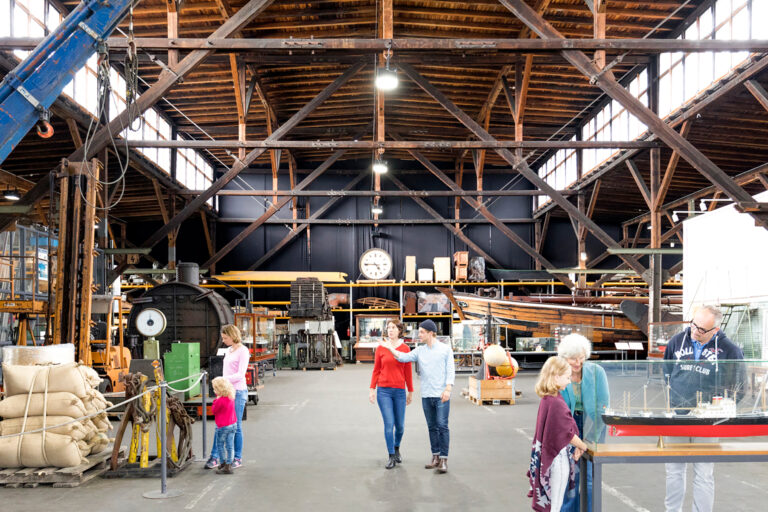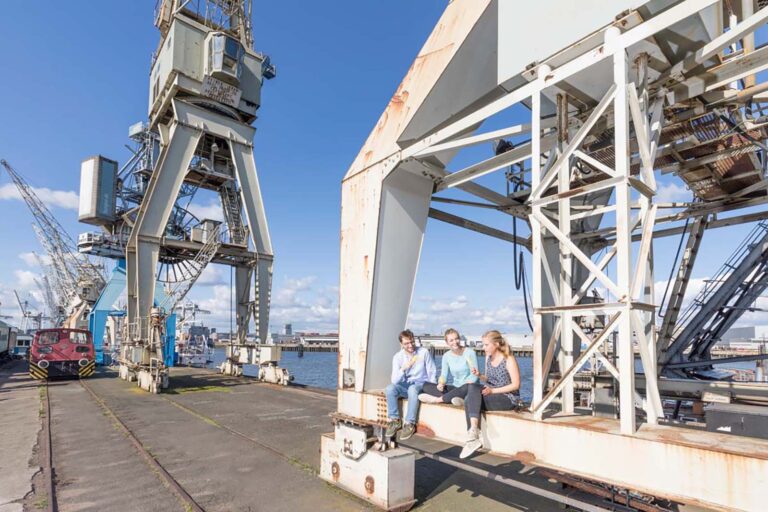German Port Museum Peking

The Port Museum Hamburg is located in the free port on the last remaining ensemble of quay sheds being today under preservation order. The structure of the quay was built 100 year ago and once ensured the optimal handling of goods between the ship moored to the quay and the traffic on land.

Virtual tour of PEKING!
Even if the ship is currently not accessible, you can now take a walk on the PEKING from home and look around all decks and in the hold! In cooperation with Google Arts & Culture, we have created virtual tours of the four-masted barque PEKING. With the help of the arrows you can navigate directly in the picture.
You can also immerse yourself in the history of the ship at g.co/HafenmuseumHamburg.
Permanent exhibitions

SHOP
Our museum shop “Zampelbüdel” was named after the linen bags used by the dock workers to transport their personal belongings for daily use. Here you can buy souvenirs such as books and postcards, key rings, ship models, maritime clothing, coffee and tea varieties and many other port-related souvenirs.
The opening hours are the same as for the Port Museum.
Maritime Circle Line
Visit the Port Museum Hamburg on the waterway – with a launch of the Maritime Circle Line.



German Port Museum
With the new German Port Museum, the international museums landscape gained a prestigious museum for the commercial and economic history of Germany’s largest port. In addition to covering the development of the port, the museum also deals with questions of globalisation and worldwide trade.
A great idea becomes reality
In November 2015, the German Federal Parliament’s budget committee approved 120 million Euros of funding to establish the German Port Museum as a new museum in the Historic Museums Hamburg group.
Part of the funding will be used to refurbish the PEKING, an historic four-masted, steel-hulled barque, and bring it back to Hamburg from New York. The PEKING will be anchored as a figurehead at the entrance to the German Port Museum. At the moment, she is located at the Hamburg Port Museum.
This legendary P-Liner represents an important era of merchant shipping and visitors will soon be able to enjoy it as a museum ship.
This unique ensemble gives the Historic Museums Hamburg yet another identification point for maritime Hamburg and for the history of Germany as a trading nation. The Historic Museums Hamburg Foundation already has more than 500,000 artefacts relating to the economic and cultural history of the port which can be used in a modern way to give people an understanding of how the port of Hamburg developed into a key location for international trade.
The concept for the German Port Museum will make full use of the expertise and experience of the many existing institutions and initiatives in the City of Hamburg and will concentrate their wealth of knowledge and the diversity of the objects at one location.




The future German Port Museum and its flagship object PEKING will be the heart of the new Grasbrook district in Hamburg. As an attractive open-air museum, the existing Hamburg Harbor Museum forms a branch of the new museum.

As an attractive open-air museum, the existing Hamburg Port Museum forms a branch of the new museum. The PEKING is located here until the new museum building of the German Port Museum is completed.
About the PEKING
The PEKING is a sailing cargo ship, built in 1911 by Blohm & Voss for the Hamburg shipping company Laeisz, with a steel hull, four masts and a technical elegance that has characterized all Flying P-Liners. She will be the leading object of the German Harbour Museum, and not only because she will be the museum’s largest object.
With its history and its significance in the global network at the beginning of the 20th century, the ship is intended to help us better understand our complex world today. The PEKING is one of the last great freighters to be able to compete against steam and engine ships at the beginning of the 20th century due to its speed, safety and precision. She proved this as a transport ship for the saltpetre from Chile, which was in great demand at the time. Saltpeter (sodium nitrate) from the Atacama Desert was used as a nitrogen fertilizer and in the production of black powder.
The success of the Flying P-Liners, of which 65 were built, was based not only on the perfect teamwork of the 30 crew members but also on the reliable speed of the “flying” ships. The increase in the efficiency of steam and machine ships then heralded the end of this success story. And the great saltpetre passages were sealed by the invention of artificial fertilisers after the First World War and the opening of the Panama Canal.
PEKING was restored at the Peters shipyard in Wewelsfleth. After the restauration, PEKING was tugged up the Elbe river to her berth at the German Harbour Museum. The ship is currently not accessible to the public, but will be soon.





